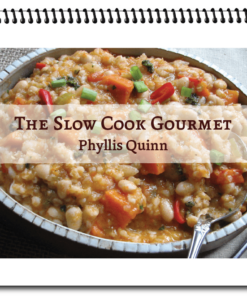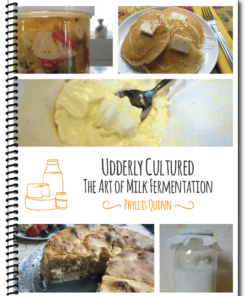Ask Chef Phyllis:
Have you heard about the big fermented food craze? What should I know about gut health? My sister Aggie told me that yogurt is good for us (and a good substitute for our favorite double chocolate fudge ice cream) because of its live cultures. But we’ve still never tried kimchi, kefir, or kombucha. Although I see them in the supermarket, I’m not even sure what they are. I’d like to try to ferment something at home for us. Someone suggested sauerkraut as a beginner food to try since it’s so available. What do you suggest?
—Lois and Agnes Griffin, Cambridge, MA
Scientists say that our gut is our second brain, and nutritionists say that it needs to be fed too. Sauerkraut is a superfood, particularly when it comes to gut health, and I highly recommend it as a good place to start.
But first, we should ask ourselves why the art of fermentation isn’t more well known, given its serious health benefits. Perhaps it’s because our society today is plagued by misinformation: fat is bad, cholesterol leads to heart disease, and gluten is poison. People even used to believe that whole grains were for the poor. Fortunately, these days we have television programs such as the Dr. Oz Show promoting what Selene River Press, a leading educator on holistic health care, and its contributors have been saying for years about the link between health and nutrition.
In my opinion, we used to be healthier eaters. The norm was to bring home real, whole food and prepare it yourself. Then social mores changed. Way back when Quonset huts and roller skating waitresses were still around, we experienced the advent of fast food, TV dinners, canned soups, and frozen, processed meals. This may have made the working wife’s life easier, but at the same time, the rates for a whole host of ailments—including diabetes, leaky gut, obesity, acid reflux, and inflammation—began to rise.
Fermenting vegetables to preserve them isn’t new, but we’ve only begun to learn what fermentation can do! Older than canning, this method of preserving food offers unique benefits. New and ongoing research shows that the trillions of bacteria found in fermented foods can help with intestinal problems. Fermented food also feeds the gut flora with lactic acid, which allows the flora to flourish and helps maintain proper pH levels.
By no means am I an expert on fermenting foods, nor have I traveled the world in search of more exotic ferments like my hero Sandor Ellix Katz (look for his books Wild Fermentation and The Art of Fermentation, as well as Making Sauerkraut and Pickled Vegetables at Home by Klaus Kaufmann and Annlies Schoneck). Yet even though I’m no expert, I’ve mastered how to ferment sauerkraut, a quintessential superfood!
The following story is enlightening and the message is clear, so please read on.
The Lifesaving Story of Sauerkraut, a Superfood
Let’s look at what historians have to say about Captain Cook’s successful sea voyage on the HM Endeavor in 1768, when he set sail from England to the South Pacific. Before that, way back in 1753, Scottish naval surgeon James Lind noted that scurvy was linked to those whose diets were severely limited. Shipboard illnesses took thousands of lives, but scurvy was a particularly nasty death. The good doctor discovered that fresh fruit, especially citrus fruit, alleviated the problem. We’ve all heard of “limeys,” and sure enough limes and other citrus fruits worked for short-term voyages. However, there was another dilemma. How do you store fresh foods, especially those that contain vitamin C, on extremely long ocean voyages? The answer is: you can’t.
In the 1760s, with no real cure in sight, the British Crown decided to outfit four merchant ships with different experimental foods. Captain James Cook’s ship was one of them. In his log of provisions, among several different foods to be tested were 7,860 pounds of sauerkraut.
On its own, cabbage isn’t a major source of vitamin C. But when thinly sliced cabbage, left in its own juices along with some salt, is left to ferment into sauerkraut, the resulting lactic acid preserves the C complex. And the C complex—although not known at the time of Cook’s voyage—is the key for preventing and curing scurvy.
The happy ending is that no one on the Endeavor died of scurvy during that voyage. Sour cabbage, or sauerkraut, saved the sailing industry at a time when a lack of vitamin C resulted in scurvy, making long sea voyages not only deadly but unprofitable. Now that’s motivation! What helped sailors survive can also help us. Sauerkraut is one of the easier ferments to master, and it’s simple to make at home. It’s a great source of the C complex, many essential enzymes, and the critical lactic acid mentioned above. It also retains whatever nutrients the cabbage took in if it was grown in healthy soil.
For help learning how to ferment, check out Sally Fallon’s Nourishing Traditions and websites like Cultures for Health. And in three easy steps, Lois, you’ve done it!
Sauerkraut
Ingredients
1 large organic green cabbage
1–2 tablespoons sea salt (I use the lesser amount)
1 tablespoon caraway seed (optional for Bavarian style sauerkraut)
Special equipment: 1 wide-mouthed half-gallon jar with a plastic lid and 1 wooden cabbage crusher or large wooden spoon
Instructions
- Chop or thinly slice cabbage. Place in a large bowl. Add salt (I recommend starting with the lesser amount and adding more as needed). Knead cabbage with clean hands until it begins to release liquid.
- Scoop cabbage into glass jar. Pound with a cabbage crusher, potato masher, or large wooden spoon. Make sure brine or cabbage juices rise above the cabbage. If necessary, add more salt a little at a time.
- Seal and set at room temperature (65°F) for 7 days.
- Burp (open the seal) almost every day to let gasses escape, if necessary. You should see bubbles rising up in the liquid. Taste after a week to 10 days. When ready, put into cold storage.
Chef’s note: You can purchase sauerkraut in glass jars at almost any supermarket. However, make sure the ingredients are cabbage and sea salt only. I have a batch of sauerkraut that’s been stored in my downstairs fridge for a year and a half already. It’s loaded with flavor, and it’s much more delicious than the week I made it (although it was good then). Eighteen months later, and it’s still very crisp. In fact, aging improved it. There’s not much in life that you can say that about. Oh, maybe wine, which is also fermented.
Image from iStock/iuliia_n.





